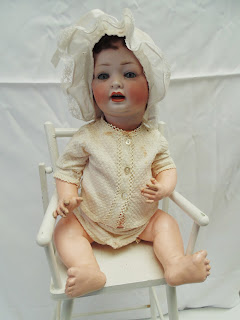From the NYT: I am sharing it here for the sake of nostalgia. My first doll book was "Dolls." I was 7.
John D. Noble, 80, Expert On Toys and Dolls, Is Dead
By DOUGLAS MARTIN
Published: October 12, 2003
John Darcy Noble, who so adored dolls and toys that he became a leading museum curator, theorist, collector and creator of playthings, died on Sept. 21 at his home in Vista, Calif. He was 80.
The cause was complications of diabetes, said his companion of 44 years, Robert M. Clement, his only survivor.
Mr. Noble was curator of toys at the Museum of the City of New York, perhaps one of the first to hold such a position at a major museum. He wrote extensively on toys, particularly dolls, and was an important voice in the intellectual movement to interpret the artifacts of childhood as significant cultural symbols.
''He was the foremost authority on dolls and toys in the world in terms of having a scholarly understanding of them,'' Martha Longenecker, founder and president of the Mingei International Museum in San Diego, said in an interview.
Mr. Noble himself made whimsical paper dolls, including one of a bride who loved cats -- a cat rode on the train of her gown. ''His creations will be the rare, sought-after treasures of the future,'' Gene Maiden, who collects and writes about paper dolls, said in an interview. ''There was an aesthetic no one else had: a subtlety, a wit and a humor.''
Mr. Noble glorified playfulness. He liked to point out that the mythical gods on Mount Olympus passed their days in play, something he said other creatures, like otters and whales, also do.
''Only Man, with his anxieties and his self-consciousness, rejects play as childishness, relegating it to his children, and expressing this most innocent and holy of urges only in the cupidity of card games, or the evasion of spectator sports,'' he wrote in 1987 in a catalog for an exhibition at the Mingei Museum.
The son of a blacksmith, John Darcy Noble was born on March 21, 1923, in Brockley, a suburb of London he described as Dickensian in character. He was educated at Goldsmith's College of Art in London, where his mentor was Betty Swanwick, the figurative and romantic painter and illustrator. At Goldsmith, he began a lifelong friendship with the author Quentin Crisp.
After graduating, Mr. Noble made costumes and props for ballet, theater and the Royal Opera; collected and dealt in antiques, and cultivated relationships with the British art and theater avant-garde. Coco Chanel bought one of his painted works at a Paris exhibition.
He began to collect old toys at 6 when a schoolmate brought to school a china whistle in the form of a baby astride a cigar. He gave his friend a puzzle in exchange and soon had a brisk trade going.
By age 10, he had a large collection of toys, some quite rare, and discovered there was a paucity of books on dolls and toys. He did his own research and became an expert on toys while still in his teens. He ultimately published four books and many articles on dolls.
In an introduction to his book ''A Treasury of Beautiful Dolls'' in 1971, the doll authorities Dorothy, Elizabeth and Evelyn Coleman wrote, ''Thanks to the efforts of scholarly and sensitive people like John Noble, old dolls are beginning to be recognized as important historical artifacts.''
In an interview with The New York Times in 1998, Mr. Noble explained part of his rationale for focusing on toys as a clue to understanding earlier mores.
''Toys weren't bought by children,'' he said. ''They were bought by parents who had social standards.''
By his mid-20's, Mr. Noble was a personality in the world of toys and was captured in a newspaper picture with Vivian Greene, Graham Greene's wife and an authority on dollhouses. The caption called them ''two noted eccentrics of the collecting world.'' They became lifelong friends.
He was working at Pollock's Toy Museum in London in 1960 when he visited New York for a long summer holiday on Fire Island. He became a consultant to the Museum of the City of New York to catalog its extensive doll collection. He became the full-time curator of toys, a new position, in 1961 and continued in the post until his retirement in 1985.
The seriousness of his approach was suggested by an exhibition of dollhouses in 1977. The house had black servants, who might have been slaves. In an interview with The New York Times, he said that in his early years at the museum, these dolls might have been packed away for fear that if they were shown, blacks would be offended.
''Now we show them taking their true place in history,'' he said.
Mr. Noble more than doubled the museum's toy and doll collection. He championed the emerging contemporary artists who were making dolls, with exhibitions called ''Faerieland in New York'' and ''Flights of Fancy.''
Mr. Noble was consecrated a bishop in the Church of the Beloved Disciple in 1980, a Manhattan church created to reach out to the gay and lesbian community. He and Mr. Clement, who is also a bishop, were in the process of founding another branch of the church in Los Angeles.
Phyllis Magidson, curator of costumes and textiles at the City Museum, recalled Mr. Noble as ''a pixilated man -- as in whimsy and playfulness,'' and chuckled at the memory of one of his favorite lecture topics. In it, he pooh-poohed the sanctity of the pristine preservation of dolls.
The lecture's title: ''Go Ahead and Re-dress It, Honey; No One Will Ever Know.''
Photo: John Darcy Noble arranging the figures for a 1974 Christmas display. (Photo by Museum of the City of New York)








